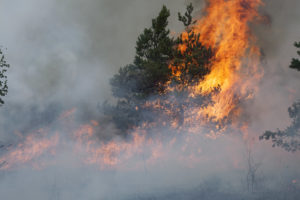When you work in the forest – whether for forestry or oil and gas – it’s not uncommon to be working amid wildfires. How can employers be prepared for this?

Photo credit: iStock.com/Viesinsh
I’ll never forget the footage of people driving away from the Fort McMurray fire. One year ago, on May 3, 2016, more than 90,000 people fled an out-of-control wildfire.
With that in mind, here’s a question for employers in wildfire country: “If you needed to evacuate your crew, would you be ready?”
WorkSafeBC’s Wildfire Evacuation Planning asks employers that question. This one-page checklist is designed to get employers thinking about this aspect of their emergency response planning.
Getting your crew to safety
“The checklist gets employers to identify key elements that need to be covered off to get a crew to safety,” says Lisa Houle, a forest industry specialist with WorkSafeBC.
Lisa has first-hand experience working in a wildfire zone. She worked as a treeplanter years ago, which I wrote about in my post Treeplanters need the right boots to avoid slips, trips and falls.
“We had a couple of episodes where our firm had two hours to evacuate our entire treeplanting crew,” Lisa says. “When you work in the forest – whether for forestry or oil and gas – it’s not uncommon to be working amid forest fires. Employers really need to consider ahead of time ‘When is it time to instigate an evacuation?’ and ‘How would we do it?’ It’s not always straightforward.”
Emergency response planning takes practice
Planning for emergencies in remote locations is required by law in B.C. This is complicated for employers with crews in remote locations. They need to be ready if a worker is injured or there’s a forest fire, earthquake, or other disaster.
“Emergency response planning is not just about helping an injured worker. It’s about being able to get your crew to safety for any reason,” says Lisa, who suggested this new resource after seeing bad fire seasons in B.C. and the Fort McMurray Fire of 2016 that forced 8,000 oilsands workers to evacuate their camps.
For more information, see Emergency Response Planning from the BC Forest Safety Council.
Another thing to remember is that practising emergency response plans is just as important as making them. This is the message behind the video Every Minute Counts: Emergency Response Planning in Forestry, which I wrote about last year.


